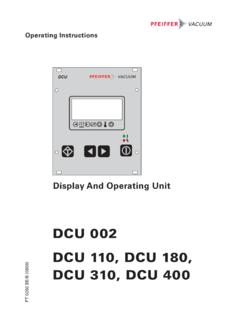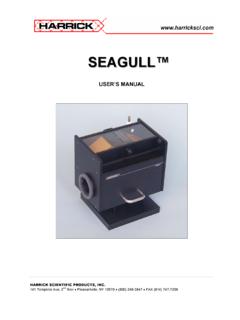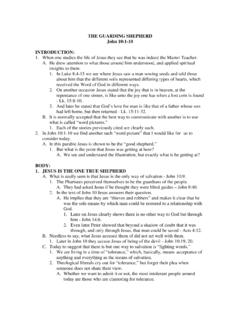Transcription of Working with Turbopumps - California Institute of Technology
1 Working with TurbopumpsIntroduction to high and ultra high vacuumproduction2 Working with TurbopumpsEmpty space, meaning a volume not filledwith air or any other gas is referred to as a vacuum. Ideal vacuum conditions existin interstellar space. In interstellar spacethere is a particle density of one atom per cm3. In a laboratory or in industry, a vacuum is created using various vacuumpumps. Different requirements pertainingto the quality of the vacuum are placed onthe vacuum depending on the this reason, vacuum applications are divided into the following categories:rough, medium, high and ultra-high of the most important instruments forcreating high vacuum is the turbomo-lecular pump (TMP), also referred to as aturbopump, that was developed andpatented in 1957 by Dr.
2 Willi Becker atPfeiffer Vacuum. The turbopump quicklybecame a success and now is more wide-spread than the diffusion pump whichwas the most widely used type of pumpup until that time. Its ease of operation, its long life and the oil-free high vacuum itcreates are the reasons to this day for thesuccess of the turbomolecular today, 250,000 pumps later, PfeifferVacuum is the innovative world marketleader for this pump. Working with Turbopumps covers thebasic principles concerning the use of tur-bopumps for the generation of content of this brochure is orientatedto the most important questions that ariseconcerning the generation of vacuum:What terminology is used in vacuumtechnology and how is it defined?(Chapter 1).How does a turbopump function?
3 (Chapter 2).What are the various types of turbo-pumps and what are the differences?(Chapter 2).What must I know in order to operate and to service a turbopump?(Chapter 3).What accessories are required and inwhat circumstances? (Chapter 3).Which combination of turbopump andbacking pump is necessary for my pro-cess? (Chapters 4 and 5).Examples of applications (Chapter 6)and the data lists (Chapter 7) providethe answers to specific hope that you will find this brochurean interesting and useful guide in yourdaily vacuum first turbopumpdeveloped andpatented in 1957 byDr. Willi Becker atPfeiffer Basic Principles and Definitions .. Terms used in Vacuum Technology .. 42. Turbopump The Principle.
4 Design and Operation .. Classical Turbopumps .. CompactTurbo .. MagneticTurbo .. CorrosiveTurbo ..133. Operating Turbopumps .. Electronic Drive Units .. TC 100, 600 and 750 for Conventional Turbopumps .. TCP 350 as a Separate Drive TCM 1601 for Magnetic Bearing Turbopumps .. Serial Interface .. Standby-Operations .. Rotation Speed Setting Mode .. Operating Modes for Various Gas Types .. Heating .. Venting .. Vibrations .. Frequency Analyses .. Anti-Vibration Magnetic Fields .. Turbopumps in Magnetic Fields.
5 Magnetic Fields of Safety .. Operational Safety of the Turbopump .. Safety for Operating Personnel ..194. Applying and Dimensioning Turbopumps .. The most Important Parameters .. Applications without Process Gas .. Pumping Curves .. Pressure Range from 10-6to10-8mbar .. Pressure below 10-8mbar .. Baking Out .. Residual Gas Applications with Process Gas .. Low Gas Loads < mbar High Gas Loads > mbar l/s ..265. Intake And Outlet Line Conductance Values for Molecular Flow .. Conductance Values for Laminar Flow ..306. Application Examples ..327. Data Basic Principles and DefinitionsThis chapter explains the most commonlyused terms in vacuum Technology andillustrates the principles involved.
6 In particular, terms that are directly connected to the use of turbomolecularpumps are explained. For detailed calculations, please refer to the chapter Applying and dimensioning turbo-pumps and Intake and outlet line los-ses .AbsorptionAbsorption is a sorption in which the gas(absorbate) penetrates into the interior ofthe solid body or liquid (absorbent).AdsorptionAdsorption is a sorption in which the gas(absorbate) is bound to the surface of asolid body or liquid (absorbent).Backing pumpA backing pump is a vacuum pump thatgenerates the necessary exhaust pressurefor a high vacuum pump from whosepumped gas flow is expelled againstatmospheric pressure. A backing pumpcan also be used as a rough ratioThe compression ratio is the ratio of theoutlet pressure to the intake pressure of apump for a certain is the release of absorbed oradsorbed gases from a surface.
7 The re-lease can be spontaneous or be accele-rated by physical pressure The exhaust pressure (pVV), also known asthe fore-vacuum pressure, is the pressureon the fore-vacuum side of the turbo-pump. A turbopump cannot expel againstatmosphere and requires, therefore, avacuum on the exhaust side (the fore-vacuum) which, depending on type, mustbe between and 20 mbar. Diaphragmpumps, oil-sealed rotary vane pumps,Roots pumps or other dry backing pumpsare used to generate the pressureThe final pressure is the value of the pres-sure that is asymptomatically approachedin a blanked off vacuum pump under normal operation and without the admis-sion of Terms used in Vacuum TechnologyADCEFF igure 011 The smallest turbo-pump in the at Pfeiffer are 3 different standardized flangesused in high vacuum Technology :The CF (ConFlat) flange connection is asymmetrical connection with a CU seal.
8 It is used in ultra high vacuum Technology (p<10-8mbar) because of its low leak anddesorption rates as well as its bake-outcompatibility. The flanges are standard-ized (PNEUROP 6606, ISO 3669).The ISO flange connection is a symmet-rical flange connection with elastomerseal and supporting ring. The connectionis made with clamping screws or unionrings. These flanges are used for largenominal widths in the range 1000 to 10-7mbar. The flanges are standardized(PNEUROP 6606, ISO 1609).The KF small flange connection is a symmetrical flange connection with elastomer seal and supporting ring. The mechanical connection is made withtension rings. Their application is in therough to high vacuum range from 1000 to systems are generally evacuatedstarting at atmospheric pressure.
9 Differenttypes of flow arise during evacuationdepending on the ratio of the inner dimen-sions of the components of the system tothe mean free path length of the flowinggas particles. Turbulent flows character-ized by high Reynolds numbers generally,however do not arise. During evacuation,a laminar flow will typically arise first. Asthe pressure drops, Knudsen flow takesover, followed finally by molecular different types of flow do not arisesuddenly and independently from one another (Figure 3). Instead, one type offlow goes through a slow transition toanother type of flow. The resulting phen-omena can be ascertained mathemati-cally, but the result is relatively complexformulas, especially when dealing withthe Knudsen flow; the transition phasefrom laminar to molecular conductance valueThe flow conductance value (C) of an ori-fice, a pipe or a piece of a pipe betweentwo defined cross-sections is defined inFormula 4.
10 It is assumed that the tempera-ture is in equilibrium throughout terms p1and p2are the pressures inthe two cross-sections and Q is the gasflow. The result is in units of m3/s or resistanceIn most applications, the vacuum pump isconnected through a pipe to the vacuumchamber. This pipe has a flow resistancewhich depends on the ratio of pressure pdivided by gas flow Q. In the high vacuumand ultra-high vacuum range the flowresistance is independent of the unit of flow resistance is s/m-3, path lengthThe mean free path length is the meanvalue of the path of a molecule be-tween collisions with other molecules. It is in reverse proportion to the pressure(Table 1 on page 7).QC = p1- p2 Formula (ppart, v v/Kmax)Formula p v -tFormula Basic Principles and DefinitionsGas loadThe gas load or gas flow (Q) is the p v -tthroughput to a vacuum pump.














